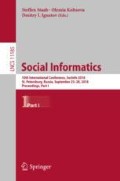Abstract
This study combined the Social Science principles of homophily and social contagion within an approach to adaptive network modeling. The introduced adaptive temporal-causal network model incorporates both principles. This model was used to analyse an empirical data set concerning delinquency behaviour data among secondary school students. A mathematical analysis provided more in depth insight in the behavior of the model.
Access this chapter
Tax calculation will be finalised at checkout
Purchases are for personal use only
References
Akers, R.L., Krohn, M.D., Lanza-Kaduce, L., Radosevich, M.: Social learning and deviant behavior: a specific test of a general theory. Am. Sociol. Rev. 44(4), 636–655 (1979)
van den Beukel, S., Goos, Simon H., Treur, J.: Understanding homophily and more-becomes-more through adaptive temporal-causal network models. In: De la Prieta, F., et al. (eds.) PAAMS 2017. AISC, vol. 619, pp. 16–29. Springer, Cham (2018). https://doi.org/10.1007/978-3-319-61578-3_2
Blankendaal, R., Parinussa, S., Treur, J.: A temporal-causal modelling approach to integrated contagion and network change in social networks. In: Proceedings of the 22nd European Conference on Artificial Intelligence, ECAI 2016, vol. 285, pp. 1388–1396. IOS Press Frontiers in Artificial Intelligence and Applications (2016)
Bosse, T., Duell, R., Memon, Z.A., Treur, J., van der Wal, C.N.: Agent-based modeling of emotion contagion in groups. Cogn. Comput. 7, 111–136 (2015)
Cairns, R.B., Cairns, B.D., Neckerman, H.J., Gest, S.D., Gariépy, J.L.: Social networks and aggressive behavior: peer support or peer rejection. Dev. Psychol. 24, 815–823 (1988)
Elliott, D.S., Menard, S.: Delinquent friends and delinquent behavior: temporal and developmental patterns. In: Hawkins, J.D. (ed.) Delinquency and Crime: Current Theories. Cambridge Criminology Series, pp. 28–67. Cambridge University Press, New York (1996)
Frederickson, B.L., Joiner, T.: Positive emotions trigger upward spirals toward emotional well-being. Psychol. Sci. 13, 172–175 (2002)
Gifford-Smith, M., Dodge, K.A., Dishion, T.J., McCord, J.: Peer influence in children and adolescents: crossing the bridge from developmental to intervention science. J. Abnorm. Child Psychol. 33(3), 255–265 (2005)
Haynie, D.L.: Friendship networks and delinquency: the relative nature of peer delinquency. J. Quant. Criminol. 18(2), 99–134 (2002)
Knecht, A.: Empirical data: collected by Andrea Knecht (2008). https://www.stats.ox.ac.uk/~snijders/siena/tutorial2010_data.htm
Kuipers, B.J.: Commonsense reasoning about causality: deriving behavior from structure. Artif. Intell. 24, 169–203 (1984)
Kuipers, B.J., Kassirer, J.P.: How to discover a knowledge representation for causal reasoning by studying an expert physician. In: Proceedings of the 8th International Joint Conference on Artificial Intelligence, IJCAI 1983, William Kaufman, Los Altos, CA, pp. 49–56 (1983)
Parunak, H.V.D., Downs, E., Yinger, A.: Socially-constrained exogenously-driven opinion dynamics. In: Fifth International IEEE Conference Self-Adaptive and Self-Organizing Systems (SASO 2011) (2011)
Pearl, J.: Causality. Cambridge University Press (2000)
Treur, J.: Network-Oriented Modeling: Addressing Complexity of Cognitive, Affective and Social Interactions. Springer, Cham (2016)
Author information
Authors and Affiliations
Corresponding author
Editor information
Editors and Affiliations
Rights and permissions
Copyright information
© 2018 Springer Nature Switzerland AG
About this paper
Cite this paper
Boomgaard, G., Lavitt, F., Treur, J. (2018). Computational Analysis of Social Contagion and Homophily Based on an Adaptive Social Network Model. In: Staab, S., Koltsova, O., Ignatov, D. (eds) Social Informatics. SocInfo 2018. Lecture Notes in Computer Science(), vol 11185. Springer, Cham. https://doi.org/10.1007/978-3-030-01129-1_6
Download citation
DOI: https://doi.org/10.1007/978-3-030-01129-1_6
Published:
Publisher Name: Springer, Cham
Print ISBN: 978-3-030-01128-4
Online ISBN: 978-3-030-01129-1
eBook Packages: Computer ScienceComputer Science (R0)

